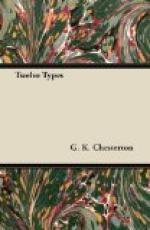This clear and fine perception of what may be called the anaesthetic element in the Victorian era was, undoubtedly, the work of a great reformer: it requires a fine effort of the imagination to see an evil that surrounds us on every side. The manner in which Morris carried out his crusade may, considering the circumstances, be called triumphant. Our carpets began to bloom under our feet like the meadows in spring, and our hitherto prosaic stools and sofas seemed growing legs and arms at their own wild will. An element of freedom and rugged dignity came in with plain and strong ornaments of copper and iron. So delicate and universal has been the revolution in domestic art that almost every family in England has had its taste cunningly and treacherously improved, and if we look back at the early Victorian drawing-rooms it is only to realise the strange but essential truth that art, or human decoration, has, nine times out of ten in history, made things uglier than they were before, from the ‘coiffure’ of a Papuan savage to the wall-paper of a British merchant in 1830.
But great and beneficent as was the aesthetic revolution of Morris, there was a very definite limit to it. It did not lie only in the fact that his revolution was in truth a reaction, though this was a partial explanation of his partial failure. When he was denouncing the dresses of modern ladies, ’upholstered like arm-chairs instead of being draped like women,’ as he forcibly expressed it, he would hold up for practical imitation the costumes and handicrafts of the Middle Ages. Further than this retrogressive and imitative movement he never seemed to go. Now, the men of the time of Chaucer had many evil qualities, but there was at least one exhibition of moral weakness they did not give. They would have laughed at the idea of dressing themselves in the manner of the bowmen at the battle of Senlac, or painting themselves an aesthetic blue, after the custom of the ancient Britons. They would not have called that a movement at all. Whatever was beautiful in their dress or manners sprang honestly and naturally out of the life they led and preferred to lead. And it may surely be maintained that any real advance in the beauty of modern dress must spring honestly and naturally out of the life we lead and prefer to lead. We are not altogether without hints and hopes of such a change, in the growing orthodoxy of rough and athletic costumes. But if this cannot be, it will be no substitute or satisfaction to turn life into an interminable historical fancy-dress ball. But the limitation of Morris’s work lay deeper than this. We may best suggest it by a method after his own heart. Of all the various works he performed, none, perhaps, was so splendidly and solidly valuable as his great protest for the fables and superstitions of mankind. He has the supreme credit of showing that the fairy-tales contain the deepest truth of the earth, the real record of men’s feeling for things. Trifling details




